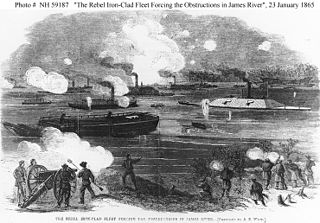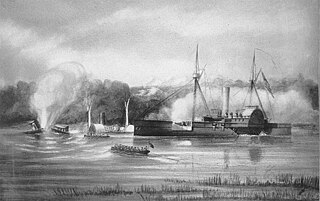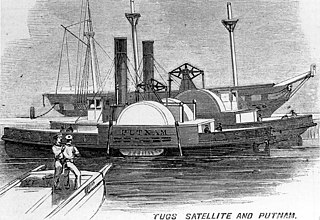CSS Scorpion was a Squib-class torpedo boat that served in the Confederate States Navy during the American Civil War. Armed with a single spar torpedo, she originally served guard duty on the James River after being built in late 1864. Along with the rest of the James River Squadron, Scorpion moved downriver on January 23, 1865, and participated in the Battle of Trent's Reach. After performing depth soundings near Union obstructions, Scorpion moved to get a lantern from the ironclad CSS Virginia II, but ran into a hawser and then ran aground. At 07:10 on the morning of January 24, Union fire struck the abandoned tender CSS Drewry, which then exploded. The force of the explosion swept Scorpion out of control downriver. An attempt to rescue her that night failed, and she was captured by Union forces.

CSS Albemarle was a steam-powered casemate ironclad ram of the Confederate Navy, named for an estuary in North Carolina which was named for General George Monck, the first Duke of Albemarle and one of the original Carolina Lords Proprietor.
USS Alert was a 90 long tons (91 t) steamship named A. C. Powell purchased by the Union Navy during the first year of the American Civil War.

CSS Virginia II was a Confederate Navy steam-powered ironclad ram laid down in 1862 at the William Graves' shipyard in Richmond, Virginia. Acting Constructor William A. Graves, CSN, was the superintendent in charge of her construction. In order to conserve scarce iron plating, he ordered the ship's armored casemate shortened from the specifications given in John L. Porter's original building plans; in addition, the ship's iron-plating, while six inches thick on the casemate's forward face, was reduced to five inches on her port, starboard, and aft faces. Due to the shortening of her casemate, the number of her cannon were reduced to a single 11" smoothbore, a single 8" rifle, and two 6.4" rifles.

USS Onondaga was an ironclad monitor built for the Union Navy during the American Civil War. Commissioned in 1864, the ship spent her entire active career with the James River Flotilla covering the water approaches to the Confederate States capital of Richmond, Virginia, although her only notable engagement was the Battle of Trent's Reach. After the war, she was purchased by France where she served as a coastal defense ship in the French Navy.
The CSS Beaufort was an iron-hull gunboat that served in North Carolina and Virginia during the American Civil War. Originally launched as Caledonia at Wilmington, Delaware, in 1854, the ship was owned by James Cathcart Johnston. It saw use as a tugboat on the Dismal Swamp Canal. On July 9, 1861, Beaufort was commissioned into the navy of the state of North Carolina for use in the American Civil War. First serving on the North Carolina coast, Beaufort was present at the battles of Roanoke Island and Elizabeth City in February 1862. Escaping the Confederate defeat at Elizabeth City via the Dismal Swamp Canal, Beaufort reached Norfolk, Virginia, where she joined the James River Squadron.

CSS Fredericksburg was a casemate ironclad that served as part of the James River Squadron of the Confederate States Navy during the American Civil War. Laid down in 1862 and Launched the following year, she did not see action until 1864 due to delays in receiving her armor and guns. After passing through the obstructions at Drewry's Bluff in May 1864, she participated in several minor actions on the James River and fought in the Battle of Chaffin's Farm from September 29 to October 1. On January 23 and 24, 1865, she was part of the Confederate fleet at the Battle of Trent's Reach, and was one of only two Confederate ships to make it past the obstructions at Trent's Reach. After the Confederate attack failed, Fredericksburg withdrew with the rest of the James River Squadron. On April 3, as the Confederates were abandoning Richmond, Fredericksburg and the other vessels of the James River Squadron were burned. Her wreck was located in the 1980s, buried under sediment.

William Augustin Webb (1824-1881) was an American sailor and Mexican–American War veteran who resigned his United States Navy commission after more than 20 years of service to join the Confederate States Navy in the American Civil War. Webb was decorated for his service as Captain of the CSS Teaser, part of the James River Squadron, during the Battle of Hampton Roads (1862).

USS Wyalusing was a double-ended, side-wheel gunboat that served in the United States Navy during the American Civil War. She was named for the borough of Wyalusing in Bradford County, Pennsylvania.

USS General Putnam – also known as the USS William G. Putnam – was acquired by the Union Navy during the first year of the American Civil War and outfitted as a gunboat and assigned to the Union blockade of the Confederate States of America. She also served as a tugboat and as a ship's tender when so required.

USS Aroostook was a Unadilla-class gunboat built for the Union Navy during the American Civil War. Aroostook was used by the Navy to patrol navigable waterways of the Confederacy to prevent the South from trading with other countries.
USS Martin was a steamer acquired by the Union Navy during the American Civil War. She was used by the Union Navy for various tasks, including those of a torpedo boat, tugboat, and a picket boat, patrolling Confederate waterways to prevent the South from trading with other countries.
USS Belle was a steamer acquired by the Union Navy during the American Civil War.

USS Bazely was a steamer acquired by the Union Navy during the American Civil War. She was used by the Union Navy in a tugboat/patrol boat role in support of the Union Navy blockade of Confederate waterways.
USS Althea was a screw steamer acquired by the Union Navy during the American Civil War. The Union Navy used it as a tugboat, a torpedo boat, and a ship's tender in support of the Union Navy blockade of Confederate waterways.
USS Poppy was a steamer commissioned by the Union Navy during the American Civil War.

The Battle of Trent's Reach was one of the final major naval battles of the American Civil War. Beginning on January 23, 1865, a powerful flotilla of Confederate warships bombarded Fort Brady along the James River and engaged four Union Navy ships with the intention of breaking through the blockade to attack City Point, the base of General Ulysses S. Grant who was besieging Petersburg, Virginia. After two days of fighting, the rebels withdrew back up the river without completing their objectives.

CSS Squib, also known as CSS Infanta, was a Squib-class torpedo boat that served in the Confederate States Navy during the American Civil War. Squib was laid down in 1863, and was launched in early 1864. Her design was a form of launch armed with a spar torpedo. Initially serving on the James River as a flag of truce boat, she snuck into the Union Navy anchorage at Hampton Roads and attacked the steam frigate USS Minnesota early on the morning of April 9, 1864. Minnesota was damaged but not sunk, and Squib was able to escape back upriver. At an unknown time in mid-1864, Squib was moved by rail to the Wilmington, North Carolina, area, where she served on the Cape Fear River. Records of her service at Wilmington after November 1864 are not extant, but she may have resupplied a Confederate fortification during the Second Battle of Fort Fisher in January 1865. The next month, the Confederates withdrew from Wilmington, and Squib was scuttled off Cape Fear.

The Squib class torpedo boats were built for the Confederate States Navy during the later stages of the American Civil War. After the torpedo boat CSS David attacked and damaged the ironclad USS New Ironsides, the Confederates continued building torpedo boats with hopes of breaking the Union blockade. Four vessels of the class – CSS Hornet, CSS Wasp, CSS Squib, and CSS Scorpion – were constructed in Richmond, Virginia, in 1864. All were armed with a single spar torpedo and were powered by steam engines. Squib damaged the gunboat USS Minnesota in an attack on April 9, 1864, and was later sent to Wilmington, North Carolina, where she was scuttled in February 1865. The other three vessels of the class were all part of the James River Squadron and participated in the Battle of Trent's Reach on the night of January 23 and 24, 1865. Scorpion ran aground during the battle, and was forced downriver and out of control after the tender CSS Drewry exploded on January 24. She was later captured by Union forces and may have been burned. Hornet was sunk in a collision with another vessel on January 27, and Wasp was scuttled on the night of April 2/3, as the Confederates were abandoning Richmond.









